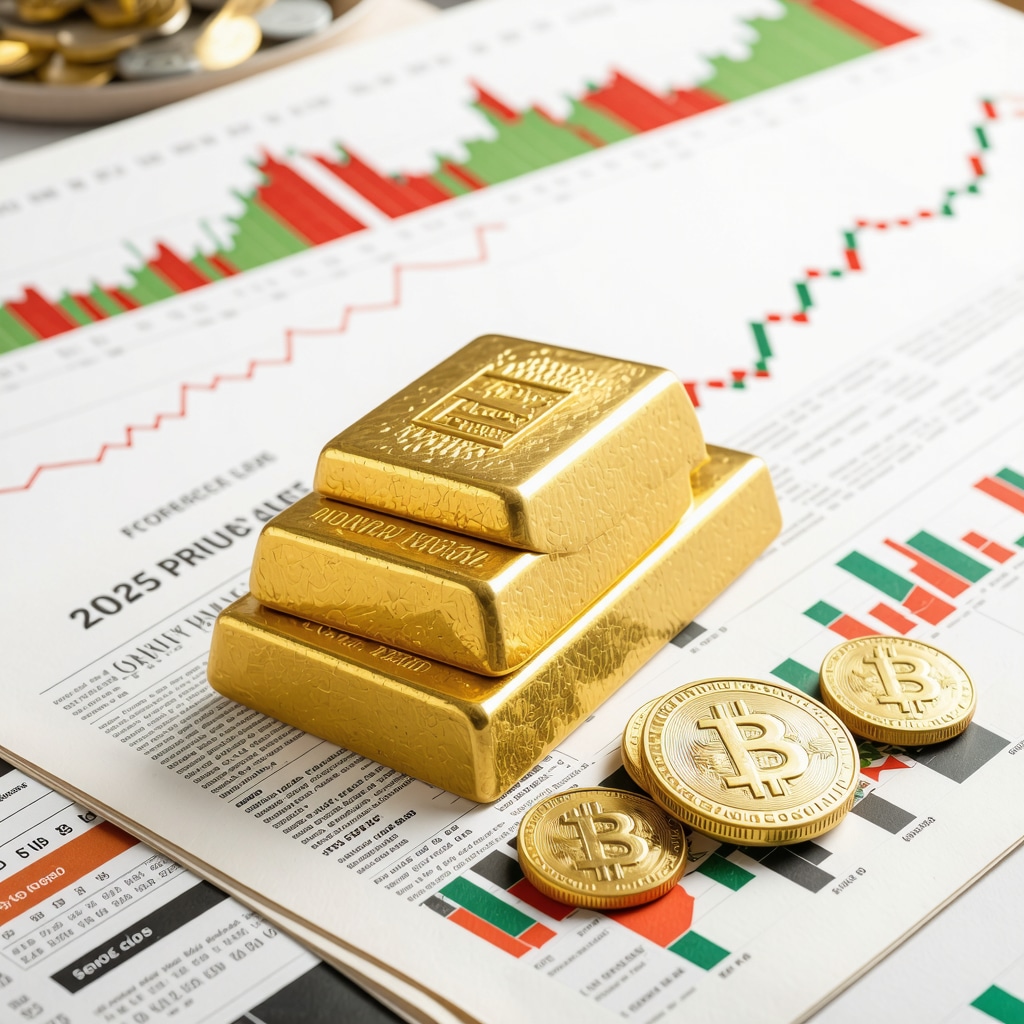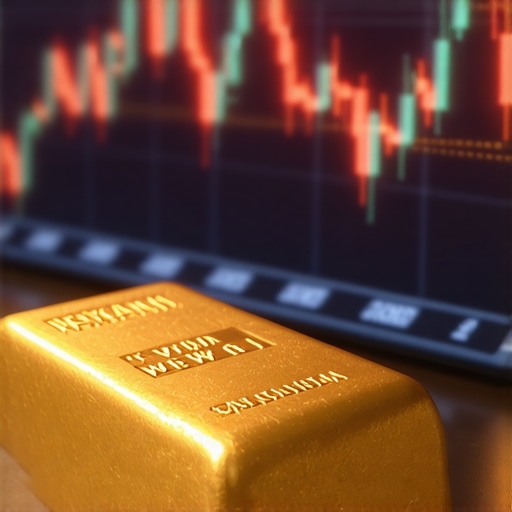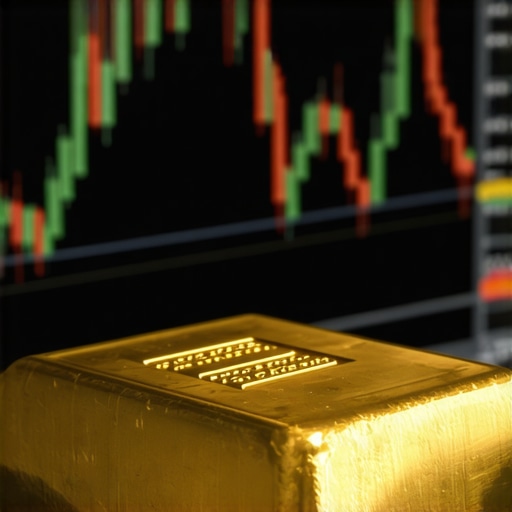Why Is Everyone Suddenly Talking About Gold Prices in 2025?
Imagine this: you’re sipping your morning coffee, scrolling through headlines blaring about gold’s meteoric rise and fall. Is gold just shiny metal, or is it the ultimate economic barometer? In the roller-coaster world of investing, gold price forecasts for 2025 have become the talk of the town, stirring curiosity among casual investors and seasoned pros alike. But what exactly is driving these trends? Buckle up, because we’re diving deep into the forces that could send gold prices soaring or stumbling in the near future.
The Golden Tug-of-War: Supply Meets Demand
At the heart of any price prediction lies the classic dance between supply and demand. Gold isn’t just mined and forgotten; it’s a sought-after asset with layers of complexity. From central banks hoarding reserves to jewelry demand in Asia, the supply and demand dynamics in 2025 will be pivotal. If mining output falters or geopolitical tensions spike, scarcity might push prices upward. Conversely, a surge in recycling or a dip in investor interest could cool the market.
Global Economic Winds: The Invisible Hand on Gold’s Scale
Let’s face it: gold reacts like a financial seismograph to economic tremors. Inflation fears, currency volatility, and interest rate maneuvers by major economies often dictate gold’s allure as a safe haven. The International Monetary Fund’s recent analysis suggests that anticipated inflationary pressures in 2025 could reignite gold’s charm among cautious investors (IMF World Economic Outlook). But will central banks’ policies dampen or fuel this frenzy? That’s the million-dollar question.
Could Geopolitical Drama Be the Wild Card in 2025?
Every seasoned investor knows to watch the geopolitical chessboard. Trade disputes, regional conflicts, and policy shifts can rattle markets overnight. Gold’s historical role as a crisis commodity means that any unexpected flare-ups might send prices skyrocketing. But predicting political drama? That’s like forecasting a thunderstorm in the Sahara—tricky at best, unpredictable at worst.
Expert Insights: What Are the Pros Saying?
Industry experts are weaving narratives enriched with data and intuition. Some point to rising demand in emerging markets and cautious monetary policies as bullish signs. Others highlight technological advances in mining and evolving investment vehicles like gold ETFs and mutual funds as game changers that might temper price volatility. It’s a nuanced conversation, blending hard numbers and human judgment.
So, dear reader, how do you see the golden road ahead? Are you gearing up to ride the waves of 2025’s gold market, or watching from the sidelines? Share your thoughts and strategies—because in the world of gold, every perspective adds a little extra sparkle.
Innovations and Investment Vehicles: Expanding the Gold Market Horizon
As we progress deeper into 2025, the gold market is no longer just about physical bars and coins. The surge in innovative financial products, especially gold ETFs and mutual funds, is transforming how investors engage with this timeless asset. These instruments offer greater liquidity and lower entry barriers, making gold accessible to a broader range of investors while simultaneously impacting price dynamics through increased trading volumes and market responsiveness.
Moreover, the rise of digital platforms and blockchain-based gold tokens is beginning to reshape the landscape, enabling fractional ownership and real-time transactions. This evolution not only democratizes gold investment but also introduces new regulatory and security considerations that savvy investors must navigate carefully.
Environmental and Technological Shifts: How Sustainable Mining Affects Gold Supply
Environmental concerns and technological advancements are increasingly influencing gold mining operations worldwide. With stricter regulations and a growing emphasis on sustainability, mining companies are innovating to reduce their ecological footprint. This shift could potentially limit gold supply if production costs rise or if certain mining projects become economically unviable due to environmental constraints.
On the flip side, advancements in extraction technologies, such as bioleaching and automation, promise to enhance efficiency and reduce environmental impact. Investors should monitor these developments closely, as they have the potential to stabilize or even increase supply, thereby influencing gold price movements in 2025.
What Role Will Central Bank Policies Play Amidst These Evolving Market Dynamics?
Central banks remain pivotal in shaping gold’s trajectory. Their buying patterns, reserve adjustments, and monetary policies often signal broader economic sentiments. In 2025, with inflation concerns persisting and geopolitical tensions simmering, will central banks act as buyers cushioning the market, or will tightening policies lead to reduced gold demand?
According to the World Gold Council’s 2023 report, central bank gold purchases have increased steadily over the past decade, reflecting a strategic shift towards diversifying reserves (World Gold Council). Understanding these policy moves is essential for anticipating price volatility and investment opportunities.
Integrating Diverse Gold Assets: Balancing Portfolios for Risk and Growth
Optimal gold investment strategies in 2025 increasingly emphasize diversification within the asset class itself. Investors are blending physical gold, mining stocks, ETFs, and even futures to balance risk, liquidity, and growth potential. For those aiming to build a resilient portfolio, resources like how to build a balanced gold portfolio with ETFs and stocks offer critical guidance for navigating this complexity.
Furthermore, distinguishing between short-term trading tactics and long-term wealth preservation strategies is crucial. Physical gold serves as a tangible hedge against inflation and geopolitical uncertainty, while gold mining stocks and ETFs may offer leveraged exposure to gold price movements and dividends.
Engaging with these nuanced investment options requires thorough market analysis and a clear understanding of individual risk tolerance and investment goals.
We’d love to hear your approach: How are you positioning your gold investments in this multifaceted market? Share your insights or questions below, and explore more expert analysis on expert gold price trends and forecasts for 2025 to stay ahead.
Unraveling Central Bank Strategies: The Invisible Steering Wheel of Gold Markets
Central banks are often the silent giants behind gold price fluctuations, wielding influence through reserve management and monetary policy shifts. In 2025, their role becomes even more intricate as inflationary pressures and geopolitical uncertainties linger. Unlike retail investors, central banks operate with macroeconomic objectives, balancing reserve diversification against currency stability.
The World Gold Council’s 2023 data reveals a nuanced trend: while some central banks continue aggressive gold accumulation, others adjust reserves cautiously in response to tightening monetary policies. This divergence highlights the complexity of forecasting gold prices based solely on central bank activity. Importantly, these institutions may act as both buyers during economic instability and sellers when liquidity needs arise, creating a push-pull effect on prices.
Moreover, the interplay between central banks and national fiscal policies introduces additional layers of unpredictability. For instance, emerging economies aiming to reduce reliance on the US dollar might accelerate gold purchases as a geopolitical hedge. Conversely, developed economies facing rising interest rates may temper gold buying to support currency strength.
How Do Central Bank Gold Reserves Impact Long-Term Price Stability Amid Market Volatility?
This question digs into the strategic reserves’ role in cushioning gold prices during turbulent times. Central banks’ reserve adjustments can signal confidence or caution to markets, influencing investor sentiment massively. When central banks increase gold holdings, it often reflects expectations of currency devaluation or inflation, prompting a bullish price environment. Conversely, selling reserves may indicate liquidity needs or confidence in fiat currencies, potentially dampening gold’s appeal.
The dynamic is further complicated by the trend of coordinated central bank actions or unilateral moves responding to global crises. Investors monitoring these signals can gain an edge in timing entry and exit points in gold investments.
Advanced Portfolio Integration: Harnessing Multi-Asset Gold Strategies for Optimized Risk-Reward Balance
Modern gold investing transcends simple bullion holding. Sophisticated investors now employ multi-asset strategies blending physical gold, mining equities, ETFs, futures, and even emerging digital gold tokens. This diversified approach leverages the unique risk-return profiles of each asset, mitigating exposure to market shocks while capitalizing on growth opportunities.
For example, mining stocks can offer leveraged upside correlated with gold prices but carry operational risks. ETFs provide liquidity and ease of trading, yet may lack the tangible security of physical gold. Futures allow tactical positioning for short-term trends but require expertise to manage margin risks. Digital tokens, while nascent, promise fractional ownership and instant transactions but introduce regulatory and cybersecurity challenges.
In crafting a gold-inclusive portfolio, investors should align asset mixes with their risk tolerance, investment horizon, and macroeconomic outlook. Resources like expert guidance on balanced gold portfolios can illuminate this complex terrain.
Innovations in Gold Investment: Navigating the Frontier of Digital Gold and Blockchain Integration
The advent of blockchain technology is revolutionizing gold investment by enabling tokenized gold assets. These digital representations of physical gold held in secure vaults provide unprecedented accessibility and flexibility, allowing fractional ownership and near-instant transfers without traditional intermediaries.
However, this innovation introduces new challenges: regulatory frameworks are still evolving, and investors must scrutinize custodial arrangements and smart contract security to mitigate fraud risks. Moreover, the liquidity and price correlation of these tokens to physical gold markets remain areas of active research.
As the ecosystem matures, integrating tokenized gold with conventional assets could offer sophisticated hedging and diversification tools. Tracking developments through authoritative sources like the World Gold Council’s research on gold tokenization is essential for staying at the forefront of this transformative trend.
Given these complexities and innovations, how are you adapting your gold investment strategies for 2025? Engage with our expert analyses and share your perspectives to deepen your market insight.
Decoding Central Banks’ Dual Role: Market Stabilizers or Price Catalysts?
Central banks wield profound influence over gold’s price trajectory, yet their maneuvers in 2025 reveal a complex duality. While some institutions aggressively accumulate gold reserves to hedge against currency devaluation and geopolitical risks, others strategically divest or pause purchases amid tightening monetary policies. This push-pull dynamic creates nuanced price signals that savvy investors must decipher to anticipate market swings effectively. The central bank gold buying effects on 2025 gold price forecast illuminate how these sovereign decisions ripple across global markets.
How Can Investors Interpret Central Bank Signals to Optimize Gold Positioning?
Interpreting central bank behavior demands a fusion of macroeconomic insight and geopolitical awareness. An uptick in gold reserves often signals caution regarding fiat currency stability and inflation, encouraging bullish sentiment. Conversely, reserve sales may reflect confidence in economic stability or liquidity needs, potentially dampening gold’s appeal. Investors who monitor official reserve disclosures, policy statements, and geopolitical developments can gain an edge by timing entries and exits aligned with these institutional cues.
Digital Gold Tokens: Navigating the Intersection of Innovation and Regulation
The rise of blockchain-powered gold tokens marks a paradigm shift in asset accessibility and liquidity. These tokens represent fractional ownership of physical gold stored in secure vaults, enabling real-time trades without traditional intermediaries. However, this innovation introduces regulatory ambiguity and custodial risks that investors must navigate prudently. The World Gold Council’s research on gold tokenization emphasizes the imperative for robust frameworks ensuring transparency, security, and price fidelity to physical gold markets.
As regulatory landscapes evolve, investors should stay informed about compliance requirements and technological safeguards to harness tokenized gold’s benefits while mitigating potential vulnerabilities.
Strategic Portfolio Integration: Crafting Resilient Gold-Infused Investment Models
In 2025, effective gold investment transcends mere ownership; it demands sophisticated portfolio construction blending physical gold, mining equities, ETFs, futures, and emerging digital assets. This multi-asset approach balances liquidity, risk, and growth, allowing investors to capitalize on gold’s diverse market behaviors. For instance, mining stocks offer leveraged exposure to price movements but introduce operational risks, while ETFs provide trading ease but lack tangible asset security.
Comprehensive guides like how to build a balanced gold portfolio with ETFs and stocks provide invaluable frameworks for aligning asset allocation with individual risk tolerance and market outlook, empowering investors to navigate volatility with agility.
What Advanced Analytical Tools Enhance Gold Market Forecasting Accuracy?
Cutting-edge investors leverage a suite of analytical tools integrating technical indicators, macroeconomic data, and sentiment analysis to refine their gold market forecasts. Utilizing AI-driven predictive models and real-time data feeds enhances the ability to detect subtle market shifts and emerging trends. Resources such as how to analyze gold market trends for smarter investment moves delve deep into methodologies that combine historical patterns with forward-looking variables, offering a tactical advantage in anticipating price swings and optimizing trade timing.
Engage with us: How are you incorporating central bank insights, digital gold innovations, or advanced analytics into your 2025 gold investment strategy? Share your expert perspectives or questions below, and explore further expert analyses on gold price trends and forecast highlights for 2025 to enrich your market understanding.

Expert Insights & Advanced Considerations
The Nuanced Role of Central Banks in Gold Price Stability
Central banks operate as both market stabilizers and catalysts in the gold market. Their dual role—accumulating reserves to hedge against inflation and geopolitical risks while occasionally divesting to manage liquidity—introduces complex price dynamics. Understanding these sovereign moves requires a macroeconomic lens, as their actions often presage broader shifts in investor sentiment and currency stability.
Blockchain and Tokenization: Redefining Gold Investment Accessibility
The emergence of blockchain-based gold tokens is more than a technological novelty; it represents a fundamental shift in how investors interact with gold. By enabling fractional ownership and instant settlement, tokenization expands market participation but also demands vigilance regarding regulatory compliance and custodial security. Investors integrating these innovations must balance newfound liquidity and flexibility with emerging risks.
Multi-Asset Gold Portfolios: Balancing Risk and Growth in 2025
Sophisticated investors increasingly blend physical gold, mining equities, ETFs, futures, and digital gold assets to optimize diversification. Each asset class offers unique risk-return characteristics—physical gold provides stability, mining stocks offer leveraged upside, ETFs ensure liquidity, and futures enable tactical positioning. Crafting a portfolio tailored to individual risk tolerance and market outlook is essential for navigating 2025’s volatile environment.
Advanced Analytical Tools Elevate Market Forecasting Precision
Incorporating AI-driven models, sentiment analysis, and comprehensive macroeconomic data enhances forecasting accuracy. These tools help decode subtle market signals and anticipate price movements more effectively. Investors employing such methodologies gain a strategic edge, particularly in volatile periods marked by geopolitical and economic uncertainty.
Curated Expert Resources
- World Gold Council Research Hub: An authoritative source for insights on gold supply, demand, and tokenization trends, essential for understanding market fundamentals and innovations.
- Buying Gold Now – Expert Analysis on Gold Price Trends: Provides in-depth forecasts and strategic guidance tailored to 2025 market conditions, integrating central bank activity and investment vehicles.
- How to Build a Balanced Gold Portfolio with ETFs and Stocks: A comprehensive guide for investors seeking to diversify within gold assets, balancing risk and growth potential effectively.
- How to Analyze Gold Market Trends for Smarter Investment Moves: Offers methodologies combining technical, fundamental, and sentiment analysis to enhance market prediction capabilities.
- Central Bank Gold Buying Effects on 2025 Gold Price Forecast: Explores the critical influence of sovereign gold reserve strategies on price volatility and investment opportunities.
Final Expert Perspective
As we navigate the multifaceted landscape of gold price forecasts for 2025, the interplay between central bank strategies, technological innovation, and diversified investment approaches emerges as paramount. Investors who grasp the subtle signals from sovereign actors, embrace advancements like digital gold tokens with informed caution, and deploy multi-asset portfolios empowered by advanced analytics will position themselves advantageously. The gold market in 2025 is not merely about holding a precious metal—it is about mastering an evolving ecosystem where expertise, agility, and insight converge.
We invite you to deepen your understanding, share your professional insights, and explore the rich resources available to refine your gold investment strategy for the coming year. Engage with the latest expert analyses on gold price trends and forecast highlights for 2025 to stay ahead in this dynamic market.











Reading this comprehensive breakdown of gold price trends for 2025 really sheds light on how multifaceted gold investment has become. I find the interplay between central banks’ buying patterns and geopolitical tensions particularly intriguing because it shows gold is more than just a safe haven—it’s a real-time gauge of global stability. From my experience, investing in physical gold gave me peace of mind during past inflationary periods, but I’m increasingly considering diversifying with gold ETFs and even exploring those emerging blockchain-backed gold tokens for liquidity. What strikes me is how sustainability and technological advances in mining could unexpectedly tip supply dynamics. I also wonder how investors weigh the potential risks of digital gold tokens against their apparent benefits. For those balancing portfolios, do you tend to prioritize physical gold for stability or lean more on investment vehicles like ETFs and mining stocks for growth opportunities? And how much does the unpredictability of geopolitical events influence your timing when entering or exiting gold positions? This article definitely encourages a more nuanced approach to gold investing rather than a one-size-fits-all strategy.